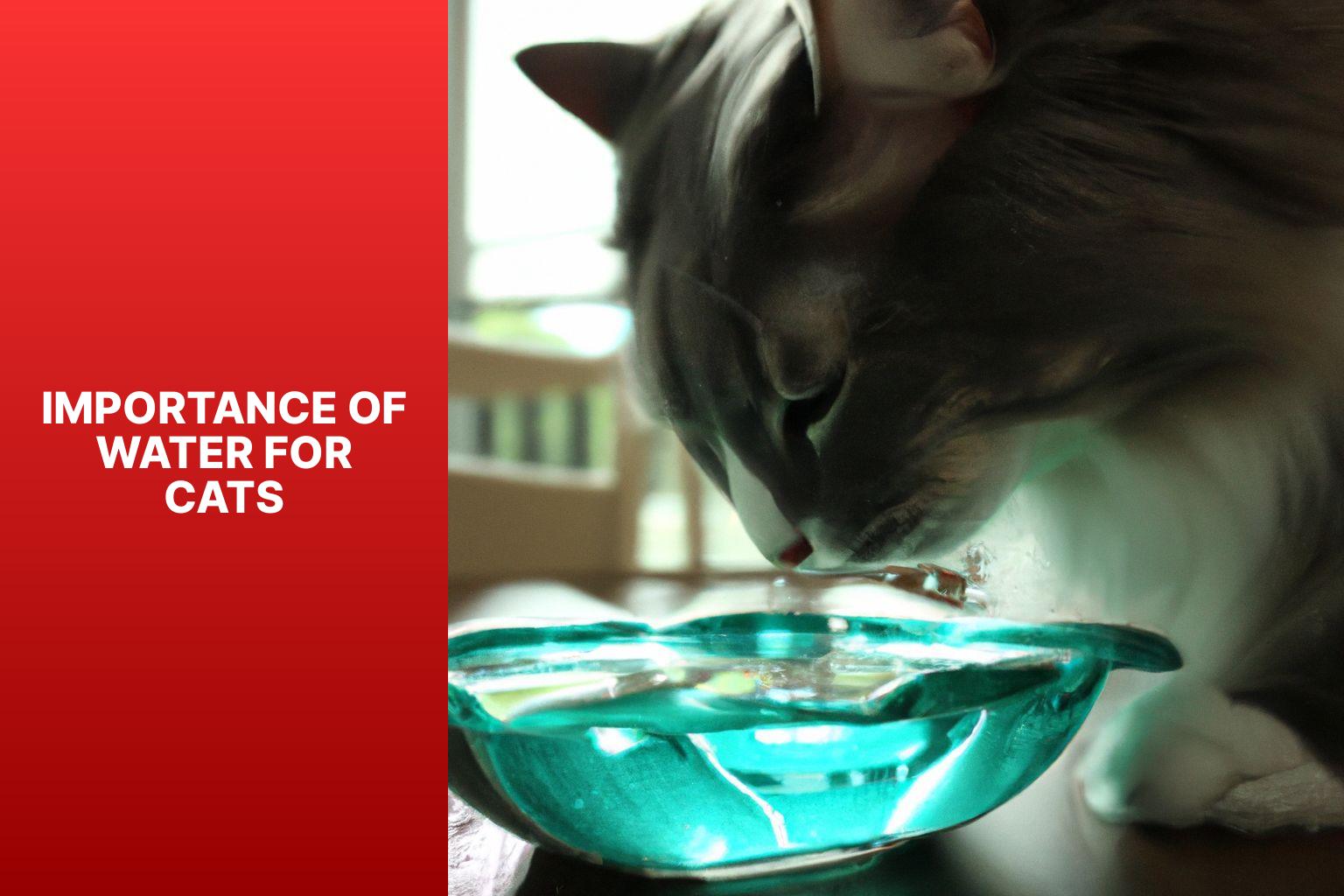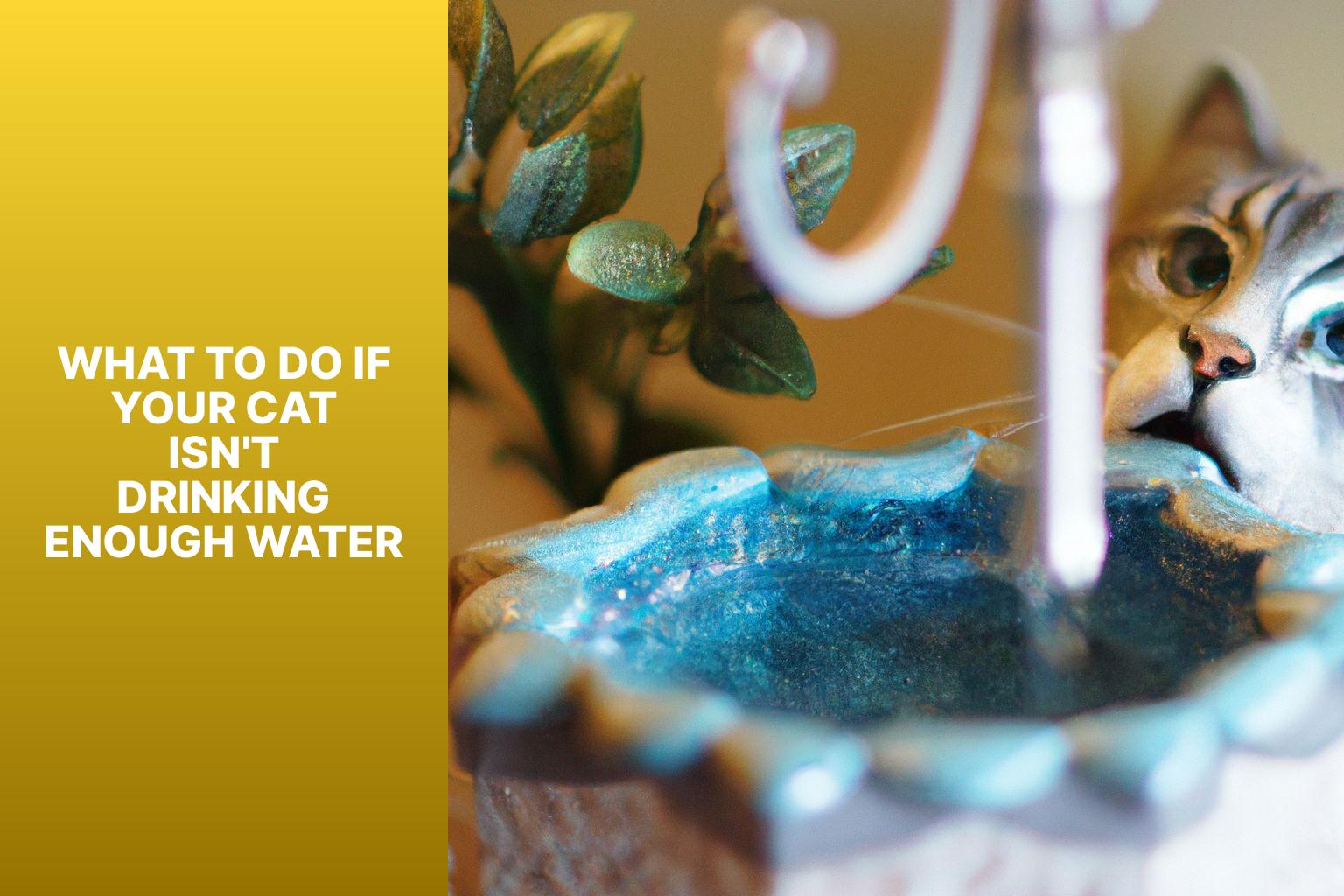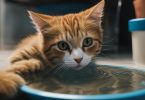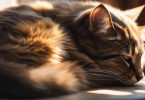Cats, like any living beings, rely on water for their bodies to function properly. Adequate water intake is crucial for their overall health and well-being. In this article, we will explore the importance of water for cats and address the question of how long a cat can go without water.
Understanding why cats need water is essential. Water plays a vital role in maintaining their bodily functions, such as digestion, circulation, temperature regulation, and waste elimination. It helps prevent dehydration and keeps their organs and tissues hydrated.
So, how long can a cat go without water? While it depends on various factors, such as age, health, and environmental conditions, cats generally cannot go without water for more than a few days. Unlike other animals, cats have a low thirst drive and may not actively seek out water when dehydrated, making it crucial for their owners to ensure they have access to fresh water at all times.
Several factors can affect a cat’s water needs, including the type of diet (dry or wet food), activity level, weather conditions, and underlying health issues. Understanding these factors can help you determine your cat’s specific water requirements and ensure they stay adequately hydrated.
Dehydration can have severe consequences on a cat’s health. It can lead to a range of physical symptoms, such as dry mouth, sunken eyes, lethargy, and weight loss. Behavioral changes like decreased grooming, irritability, and reduced appetite may indicate dehydration in cats.
To prevent dehydration in your cat, it is essential to provide them with fresh and clean water at all times. Make sure to clean their water bowl regularly and refill it with fresh water daily. You can also encourage increased water consumption by offering a variety of water sources, such as multiple water bowls or a water fountain.
If you notice that your cat is not drinking enough water, it is crucial to take prompt action. In some cases, it might indicate an underlying health issue or discomfort. Consult with your veterinarian to rule out any medical conditions and discuss strategies to encourage your cat to drink more water.
By understanding the importance of water for cats, recognizing the signs of dehydration, and taking preventive measures, you can help ensure your feline companion stays healthy and hydrated.
– Cats need water for their overall health and well-being.
– Dehydration can have serious effects on a cat’s health.
– Providing fresh and clean water and encouraging increased water consumption can help prevent dehydration in cats.
Importance of Water for Cats
Photo Credits: Www.Catcornerblog.Com by Logan King
Water is of utmost importance for the well-being and health of cats. It plays a pivotal role in maintaining hydration levels and supporting bodily functions. The significance of water for cats can be summarized as follows:
1. Hydration: Adequate water intake is crucial to prevent dehydration and ensure proper organ function and regulation of body temperature.
2. Kidney Health: Consistent water consumption is vital for maintaining kidney function and reducing the risk of urinary tract issues.
3. Digestive Health: Water aids in digestion, prevents constipation, and promotes a healthy digestive system.
4. Coat and Skin Health: Sufficient water intake promotes well-hydrated skin and coat, preventing dryness and other skin conditions.
To ensure your cat stays hydrated and healthy, consider the following suggestions:
1. Fresh Water Supply: Always provide clean, fresh water for your cat. Regularly changing the water will encourage consumption.
2. Water Sources: Offer a variety of water sources such as bowls, pet fountains, and wet food. Experimenting with different options can help increase water intake.
3. Wet Food Diet: Including wet food in your cat’s diet increases overall water consumption due to its higher moisture content.
4. Monitoring Water Intake: Keep a close eye on your cat’s water consumption. If you notice a decrease or signs of dehydration, consult a veterinarian.
Remember, proper hydration is essential for the well-being and happiness of your cat. Providing access to clean water and encouraging regular intake are vital for their health.
Why Do Cats Need Water?
Cats need water for important reasons. Water is essential for cats to stay hydrated and healthy. It regulates their body temperature, aids digestion, and flushes out toxins. Cats have a low thirst drive, so it’s crucial to provide fresh and clean water at all times to prevent dehydration and associated health issues.
Water also plays a crucial role in maintaining a cat’s urinary system. Adequate water intake prevents the formation of painful and potentially life-threatening urinary crystals and stones. It also dilutes the urine, reducing the risk of urinary tract infections.
To ensure your cat gets enough water, provide fresh and clean water in an easily accessible bowl. Some cats prefer running water, so using a cat water fountain or dripping water source may encourage them to drink more. Incorporating wet food into their diet is also beneficial, as it contains higher water content compared to dry food.
So, “Why Do Cats Need Water?” The answer is simple – water is essential for their overall health and well-being.
How Long Can a Cat Go Without Water?
Curious about how long a cat can survive without water? Let’s dive into the intriguing world of feline hydration. From exploring the factors that influence a cat’s water needs to understanding how dehydration affects our feline friends, this section will shed light on the importance of water for our beloved cats. So, hold on tight as we journey into the realm of cat hydration!
Factors Affecting a Cat’s Water Needs
Cats’ water needs can vary based on several factors, including age. For instance, kittens require more water for their growth and development, while adult cats need less. A cat’s diet can impact its water intake. Cats that eat dry food may need to drink more water to make up for the lack of moisture in their food.
Another factor to consider is the activity level of the cat. Active cats generally require more water than sedentary cats due to the increased water loss through panting and sweating. The environmental conditions can influence a cat’s water requirements. In hot and dry climates, cats may need more water to ensure they stay hydrated.
Health conditions also play a role in a cat’s water needs. Kidney disease or urinary tract issues may affect a cat’s water intake, and cats with such conditions may require increased water consumption for their well-being. Certain medications can increase a cat’s thirst, leading to higher water consumption. It is essential to monitor a cat’s water intake when administering medications.
Understanding these factors is crucial for ensuring that your cat remains properly hydrated. By considering these elements, you can provide adequate water to meet the specific needs of your feline companion.
Normal Water Intake for Cats
The normal water intake for cats varies based on size, age, and activity level. Cats should consume about 60-80 milliliters of water per kilogram of body weight per day. Individual cats may have different water intake needs.
Factors to consider regarding normal water intake for cats include:
- Size: Smaller cats require less water compared to larger cats.
- Age: Kittens and older cats may have different water intake needs. Kittens require more water for growth and development, while older cats may need more water to support their aging bodies.
- Activity level: Active and playful cats may need more water to stay hydrated, while sedentary cats may have lower water intake needs.
- Diet: Cats on a dry food diet may need to consume more water to compensate for the lack of moisture in their food, whereas cats on a wet food diet may ingest some water through their food.
- Health conditions: Certain health conditions, such as kidney disease or urinary tract issues, may increase a cat’s water intake needs.
Pro tip: Monitor your cat’s water intake by regularly refreshing their water bowl and observing how quickly they drink. If you notice a significant decrease in their water intake or signs of dehydration, consult a veterinarian for further evaluation and guidance.
The Effects of Water Deprivation on Cats
Water deprivation has serious effects on cats’ health, including physiological and behavioral symptoms. When deprived of water, cats may experience decreased urine output, concentrated urine, and constipation. They may also have dry and tacky gums, loss of skin elasticity, and sunken eyes, indicating severe dehydration.
Not only does water deprivation affect cats’ physical well-being, but it also impacts their behavior. Cats may become lethargic, lose interest in food, and show increased irritability. They may also groom excessively and exhibit discomfort.
To prevent water deprivation, it is crucial to provide cats with constant access to fresh and clean water. Encouraging them to drink can be done by offering multiple water bowls in different locations. Using wide and shallow bowls can also help. Incorporating wet food into their diet can contribute to their water intake.
If you notice that your cat isn’t drinking enough water, it is important to consult a veterinarian. They can identify any underlying health issues and provide guidance on how to increase your cat’s water intake. Remember, proactive measures are essential to ensure the well-being of your cat, as water deprivation can have severe consequences.
Signs of Dehydration in Cats
Cats can be mysterious creatures, but when it comes to their health, it’s important to be observant. In this section, we’ll uncover the telltale signs of dehydration in cats. From physical symptoms to behavioral cues, we’ll decode the messages that our feline friends may be sending us. Stay tuned to discover the subtle hints that can help us ensure our cats stay hydrated and healthy.
Physical Symptoms of Dehydration
Physical symptoms of dehydration in cats include:
1. Dry mouth: Cats may experience a sticky or dry mouth when they are dehydrated. It is important to check the moisture of their tongue and gums.
2. Pale gums: Dehydration can cause the gums to lose their normal pink color and appear pale or white, especially in severe cases.
3. Sunken eyes: Dehydrated cats may have sunken eyes that lack moisture.
4. Poor skin elasticity: One way to test hydration levels in a cat is by pinching the skin on the back of their neck. If it takes longer to return to its normal position or retains a “tent” shape, it could indicate dehydration.
5. Lethargy: Dehydration can result in cats feeling lethargic and having reduced energy levels.
6. Reduced urine output: Dehydrated cats may produce less urine and their urine color may appear more concentrated.
It is crucial to note that the intensity of these symptoms may vary depending on the severity of dehydration. If you notice any of these signs in your cat, it is important to seek veterinary attention in order to address their hydration needs.
Behavioral Signs of Dehydration
Cats exhibit behavioral signs of dehydration, so it is essential to be able to identify these signs in order to determine if your cat requires more water. Here are some indicators to be aware of:
1. Increased thirst: A dehydrated cat may drink water more frequently than usual in an attempt to replenish their body’s water levels.
2. Decreased urination: If your cat is urinating less often or experiencing a decrease in urine output, it could be a sign of dehydration.
3. Lethargy: Dehydrated cats often become tired and have reduced energy levels. They may display less interest in their typical activities and exhibit a decreased level of playfulness.
4. Loss of appetite: Dehydration can lead to a decrease in appetite for cats. They may show disinterest in their food or consume less than usual.
5. Dry gums and nose: When dehydrated, a cat’s gums and nose may feel dry to the touch.
6. Sunken eyes: Dehydration can cause a cat’s eyes to appear sunken or hollow.
If you observe any of these signs in your cat, it is important to take action. Make sure fresh and clean water is always accessible to your cat. You can encourage increased water consumption by utilizing a water fountain or incorporating wet food into their diet. If the signs persist or if you have any concerns, it is advised to consult a veterinarian for further guidance.
Preventing Dehydration in Cats
Preventing Dehydration in Cats is crucial for their overall well-being. In this section, we’ll explore effective ways to keep our feline friends adequately hydrated. From providing fresh and clean water to encouraging increased water consumption, we’ll uncover practical tips to ensure our cats stay properly hydrated. So let’s dive in and discover how we can safeguard our furry companions from the risks of dehydration.
Providing Fresh and Clean Water
Providing fresh and clean water is crucial for cat well-being. Cats are naturally drawn to flowing water, which mimics their instinctual preference for drinking from streams. To ensure regular hydration, follow these tips:
- Change water daily: Cats are sensitive to water taste and smell, and stagnant water may deter them from drinking. Replace their water dish with fresh water every day.
- Use a water fountain: Consider investing in a cat water fountain. The flowing water can entice cats to drink more and reduce the risk of bacteria growth.
- Clean the dish regularly: Wash your cat’s water dish with mild soap and hot water, removing any residue or bacteria.
- Consider filtered water: Tap water may contain impurities that can affect your cat’s health. Use a water filter or provide filtered water for clean and safe drinking.
By consistently providing fresh and clean water, you promote your cat’s hydration and overall well-being.
True story: A friend noticed significant improvements in her cat’s health after switching to a water fountain. The cat drank more water, resulting in a shinier coat and increased energy levels. This simple change had a positive impact on the cat’s well-being.
Encouraging Increased Water Consumption
To encourage cats to drink more water and promote their overall health, you can implement the following strategies to increase water consumption:
- Offer multiple water sources: Place water bowls throughout your home to make it easier for cats to access water.
- Use a wide, shallow water bowl: Cats prefer dishes that don’t interfere with their sensitive whiskers.
- Keep the water fresh and clean: Regularly change the water to ensure its quality.
- Consider a water fountain: The sound and movement of running water can attract cats and encourage them to drink more.
- Add flavor to the water: Some cats may drink more if the water has a subtle flavor.
Implementing these strategies can have a positive impact on your cat’s well-being. I once had a dehydrated cat who wasn’t drinking enough water. After trying various techniques without success, I decided to invest in a water fountain. The running water caught my cat’s attention, and he started drinking more frequently. This simple addition greatly improved his hydration and overall health. So, encouraging increased water consumption is essential for your cat’s wellbeing.
What to Do if Your Cat Isn’t Drinking Enough Water
Photo Credits: Www.Catcornerblog.Com by Patrick Wright
If your cat isn’t drinking enough water, it is important to take action to prevent dehydration and potential health issues. Here are some steps you can follow to address this concern:
– Always offer fresh water: It is crucial to ensure that your cat has constant access to clean water. Remember to change the water on a daily basis to keep it appealing.
– Consider using a larger water dish: Some cats prefer wider dishes to avoid touching their whiskers. You can experiment with different sizes and shapes to determine your cat’s preference.
– Try a cat water fountain: You may want to consider using a cat water fountain, as some cats prefer the sound and movement of running water, which can encourage them to drink more.
– Increase water intake with wet food: Another way to boost your cat’s water intake is by adding a small amount of water to their wet food.
– Set up multiple water stations: Placing water dishes in different areas of your home, especially in multi-level environments, can help to encourage your cat to drink more.
Remember to closely monitor your cat’s drinking habits and consult a veterinarian if you notice any significant changes. Dehydration can have a serious impact on your cat’s well-being, so it is crucial to address this issue promptly.
Some Facts About How Long Can a Cat Go Without Water:
- ✅ Cats can go without water for a maximum of 24 hours before dehydration sets in. (Source: Our Team)
- ✅ The normal water intake for a cat is around 40-60 milliliters per kilogram of body weight per day. (Source: Our Team)
- ✅ Cats are desert animals and can maintain their hydration with relatively little water, but they still need access to water to survive. (Source: Our Team)
- ✅ Sick cats are more prone to severe dehydration and should not go without water for too long. (Source: Our Team)
- ✅ There are several reasons why a cat might not be drinking water, including dirty or old water, physical challenges in reaching the water source, and being on an all-dry diet. (Source: Our Team)







